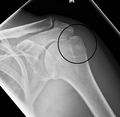Humerus fracture

Editor-In-Chief: Prab R Tumpati, MD
Obesity, Sleep & Internal medicine
Founder, WikiMD Wellnesspedia &
W8MD medical weight loss NYC and sleep center NYC
| Humerus fracture | |
|---|---|
 | |
| Synonyms | Fracture of the humerus |
| Pronounce | N/A |
| Specialty | N/A |
| Symptoms | Pain, swelling, bruising, deformity of the upper arm |
| Complications | Nerve injury, vascular injury, nonunion, malunion |
| Onset | Sudden, following trauma |
| Duration | Weeks to months, depending on severity and treatment |
| Types | Proximal humerus fracture, midshaft humerus fracture, distal humerus fracture |
| Causes | Trauma, fall, direct blow, osteoporosis |
| Risks | Osteoporosis, advanced age, high-impact sports |
| Diagnosis | Physical examination, X-ray, CT scan |
| Differential diagnosis | Shoulder dislocation, biceps tendon rupture, rotator cuff tear |
| Prevention | N/A |
| Treatment | Immobilization, surgery, physical therapy |
| Medication | Pain management, anti-inflammatory drugs |
| Prognosis | Generally good with appropriate treatment |
| Frequency | Common, especially in older adults |
| Deaths | N/A |



A Humerus Fracture is a break in the large bone of the upper arm, the humerus. This type of fracture can occur in any part of the humerus, including the ends near the shoulder and the elbow.
Types of Humerus Fractures[edit]
There are three main types of humerus fractures based on the location of the fracture:
- Proximal Humerus Fractures: These fractures occur at the top of the humerus, near the shoulder. They are most common in older people with osteoporosis.
- Midshaft Humerus Fractures: These fractures occur in the middle of the humerus. They can happen to anyone, but are often the result of a direct blow or fall.
- Distal Humerus Fractures: These fractures occur at the end of the humerus, near the elbow. They are relatively rare and usually the result of a direct blow or fall.
Causes[edit]
Humerus fractures are typically caused by a direct blow to the arm, a fall onto an outstretched arm, or a violent twisting of the arm. Certain medical conditions, such as osteoporosis or bone cancer, can weaken the humerus and make it more susceptible to fracture.
Symptoms[edit]
The most common symptoms of a humerus fracture include severe pain, swelling, bruising, and inability to move the arm. In some cases, there may be a visible deformity or the bone may even protrude through the skin.
Treatment[edit]
Treatment for a humerus fracture depends on the location and severity of the fracture. Non-surgical treatments include immobilization with a cast or splint, pain medication, and physical therapy. Surgical treatments may be necessary for more severe fractures and can include internal fixation, where hardware is used to hold the bone in place, or joint replacement.
Additional images[edit]
-
Trochanter Fracture
-
Proximal Humeral Fracture
-
Proximal Humerus Fracture
-
Mid Shaft Humerus Mark
-
Spiral Fracture
See Also[edit]
Ad. Transform your life with W8MD's Budget GLP-1 injections from $75


W8MD offers a medical weight loss program to lose weight in Philadelphia. Our physician-supervised medical weight loss provides:
- Weight loss injections in NYC (generic and brand names):
- Zepbound / Mounjaro, Wegovy / Ozempic, Saxenda
- Most insurances accepted or discounted self-pay rates. We will obtain insurance prior authorizations if needed.
- Generic GLP1 weight loss injections from $75 for the starting dose.
- Also offer prescription weight loss medications including Phentermine, Qsymia, Diethylpropion, Contrave etc.
NYC weight loss doctor appointmentsNYC weight loss doctor appointments
Start your NYC weight loss journey today at our NYC medical weight loss and Philadelphia medical weight loss clinics.
- Call 718-946-5500 to lose weight in NYC or for medical weight loss in Philadelphia 215-676-2334.
- Tags:NYC medical weight loss, Philadelphia lose weight Zepbound NYC, Budget GLP1 weight loss injections, Wegovy Philadelphia, Wegovy NYC, Philadelphia medical weight loss, Brookly weight loss and Wegovy NYC
|
WikiMD's Wellness Encyclopedia |
| Let Food Be Thy Medicine Medicine Thy Food - Hippocrates |
Medical Disclaimer: WikiMD is not a substitute for professional medical advice. The information on WikiMD is provided as an information resource only, may be incorrect, outdated or misleading, and is not to be used or relied on for any diagnostic or treatment purposes. Please consult your health care provider before making any healthcare decisions or for guidance about a specific medical condition. WikiMD expressly disclaims responsibility, and shall have no liability, for any damages, loss, injury, or liability whatsoever suffered as a result of your reliance on the information contained in this site. By visiting this site you agree to the foregoing terms and conditions, which may from time to time be changed or supplemented by WikiMD. If you do not agree to the foregoing terms and conditions, you should not enter or use this site. See full disclaimer.
Credits:Most images are courtesy of Wikimedia commons, and templates, categories Wikipedia, licensed under CC BY SA or similar.
Translate this page: - East Asian
中文,
日本,
한국어,
South Asian
हिन्दी,
தமிழ்,
తెలుగు,
Urdu,
ಕನ್ನಡ,
Southeast Asian
Indonesian,
Vietnamese,
Thai,
မြန်မာဘာသာ,
বাংলা
European
español,
Deutsch,
français,
Greek,
português do Brasil,
polski,
română,
русский,
Nederlands,
norsk,
svenska,
suomi,
Italian
Middle Eastern & African
عربى,
Turkish,
Persian,
Hebrew,
Afrikaans,
isiZulu,
Kiswahili,
Other
Bulgarian,
Hungarian,
Czech,
Swedish,
മലയാളം,
मराठी,
ਪੰਜਾਬੀ,
ગુજરાતી,
Portuguese,
Ukrainian







